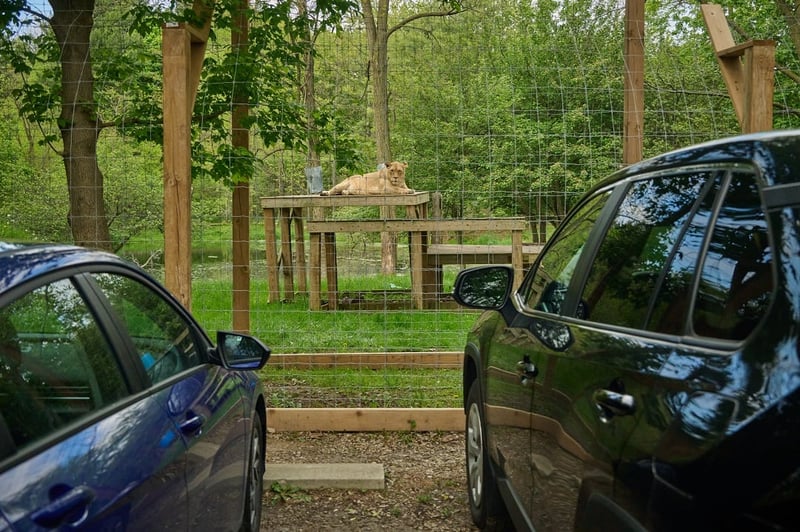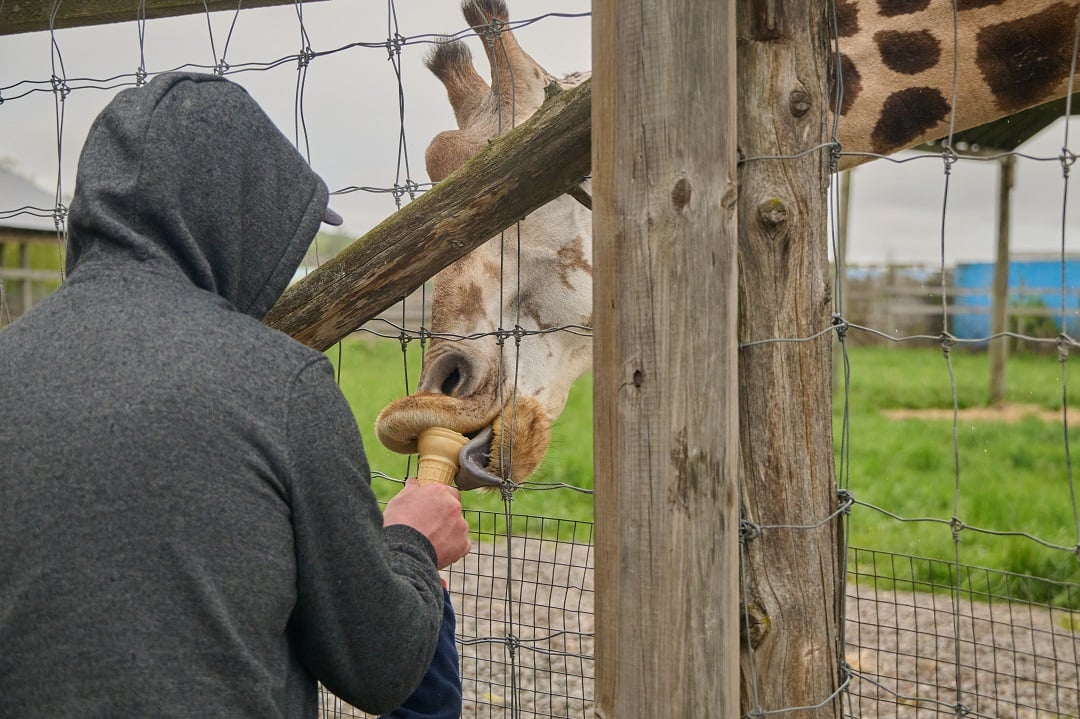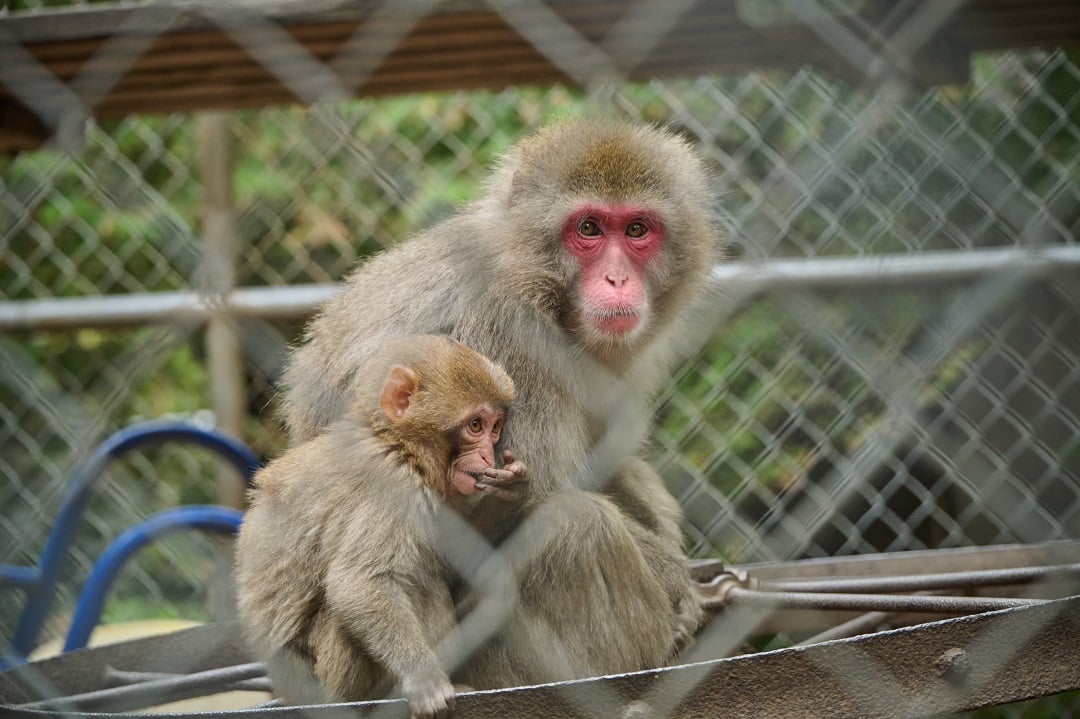
How to know you’re at a roadside zoo
Blog
It’s a sunny weekend and you’re looking for something to do with the kids. As animal lovers, the idea of visiting wild animals up close is appealing. You look up the closest wild animal park and head out the door. But as you enter through the gates, something feels... off.
Not all animal facilities are created equal. Some prioritize animal welfare and conservation. Others, like roadside zoos, exploit animals for profit and cut corners when it comes to care. But how do you tell the difference?
Here are key warning signs you might be at a roadside zoo, and not a true sanctuary:
They allow direct contact with wild animals 🚩
If visitors are permitted to pet, feed or take selfies with any wild animal, whether it’s a lion cub, a deer, a snake or anything in between, that’s a major warning sign. These experiences may seem fun, but they’re incredibly stressful and potentially dangerous for the animals (and yourself!)
 A guest feeding a giraffe an ice cream cone provided by the roadside zoo. (Photo: Sasha Rink / World Animal Protection)
A guest feeding a giraffe an ice cream cone provided by the roadside zoo. (Photo: Sasha Rink / World Animal Protection)
What real sanctuaries do instead:
Genuine sanctuaries prohibit direct human interaction to protect animals’ wellbeing. They don’t breed animals ever and they don’t use them for photo ops or force them to interact with the public. They also may only open to the public a few days each year to limit the stress on their animals.
Enclosures are small, dirty or barren 🚩
Look around. Are the cages cramped, barren or filthy? Is each enclosure designed to accommodate the specific needs of each species? Do birds have room to fly? Do foxes have dirt to dig and burrow? Do monkeys have structures to climb? Do the animals look lethargic, agitated or show repetitive behaviours like pacing or swaying? Is there anywhere for them to hide, or are they forced to be on display all the time?
This could indicate:
- Lack of proper enrichment or mental stimulation
- Chronic stress
- Poor veterinary care
What accredited facilities offer:
Naturalistic enclosures designed to meet each species’ physical and psychological needs. Enclosures are large enough and provide places to hide, providing the animals with choices.
It’s all about the money 🚩
Is the attraction focused on souvenirs, snacks and animal encounters, rather than conservation or education?
Watch out for:
- Aggressive upselling of animal experiences
- Vague or misleading signs about the animals’ origins
- No mention of how animals are rescued or cared for long-term
- No mention of how the zoo is contributing to conservation of the species in the wild
What genuine sanctuaries do:
They’re transparent about their mission, how they care for animals and how your donation supports rescue and rehabilitation.
They breed wild animals 🚩
Many roadside zoos breed their animals to attract visitors – nothing is more appealing than a baby animal! But what happens when those babies grow up?
Often, they’re sold to other roadside zoos or private collectors, neglected or used for breeding again to ensure a never-ending supply of baby animals to entice visitors. Breeding does nothing to help conservation (these animals will never be reintroduced in the wild) and can often lead to inbreeding and poor health.
 A Japanese macaque baby with their mother. (Photo: Sasha Rink / World Animal Protection)
A Japanese macaque baby with their mother. (Photo: Sasha Rink / World Animal Protection)
Sanctuaries do NOT breed. Their focus is on providing a safe haven for animals who have been rescued from abusive or exploitative situations.
Accreditation isn’t a guarantee
Some zoos have industry accreditation, but this doesn’t always mean their animals are well cared for or protected from exploitative experiences. Accreditation standards are often set by other zoos, not independent experts.
Instead, look at what you can see: Are the enclosures natural and spacious? Do the animals get to express their normal behaviours? Are direct contact or photo ops allowed?
Real sanctuaries focus on animal welfare above all else. They don’t breed, allow visitor interactions or compromise the animals’ well-being. Conditions speak louder than any certification.
The animals were born in captivity or captured from the wild 🚩
Beware of attractions that claim animals are “rescued” but actually acquire animals from breeders or the exotic pet trade. A real sanctuary never purchases animals and does not remove them from the wild unless they are injured and non-releasable.
What you can do
If you live in Ontario, the most critical action you can take is to contact your MPP and urge them to support the Captive Wildlife Protection Act – a bill that would introduce mandatory licensing, inspections and animal welfare standards for all zoos in the province. (Find your MPP and their contact info here)
If you suspect you’re at a roadside zoo:
- Leave a review to warn others not to visit.
- Report welfare concerns to provincial authorities or an animal protection group.
- In Ontario, you can call the Ontario Animal Protection Call Centre at 1-833-9-ANIMAL (264625)
- Don’t support facilities that exploit animals for entertainment.
- Make the pledge to never visit a roadside zoo again.
Together, we can end roadside zoos for good and build a future where all animals are treated with compassion and respect.
Banner photo: Sasha Rink / World Animal Protection